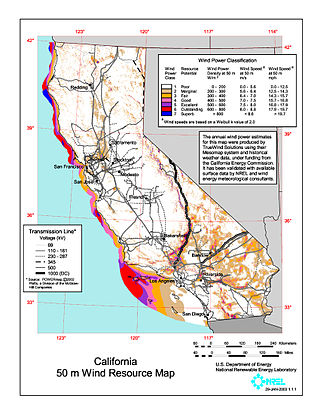
Wind power in California had initiative and early development during Governor Jerry Brown's first two terms in the late 1970s and early 1980s. The state's wind power capacity has grown by nearly 350% since 2001, when it was less than 1,700 MW. In 2016, wind energy supplied about 6.9% of California's total electricity needs, or enough to power more than 1.3 million households. Most of California's wind generation is found in the Tehachapi area of Kern County, California, with some large projects in Solano, Contra Costa and Riverside counties as well. California is among the states with the largest amount of installed wind power capacity. In recent years, California has lagged behind other states when it comes to the installation of wind power. It was ranked 4th overall for wind power electrical generation at the end of 2016 behind Texas, Iowa, and Oklahoma. As of 2019, California had 5,973 megawatts (MW) of wind power generating capacity installed.
Wind power in Ohio has a long history, and as of 2016, Ohio has 545 megawatts (MW) of utility-scale wind power installations installed, responsible for 1.1% of in-state electricity generated. Over 1000 MW more were under construction or pending approval. Some installations have become tourist attractions. There has been a sudden increase in generating capacity, as the total wind power capacity in the state was just 9.7 MW in 2010. By 2019, there were 738 MW of capacity, which generated 1.71% of Ohio's electricity.

Making up over 62% of the state's generated electricity in 2022, wind power is the largest source of electricity generation in Iowa. In 2020, over 34 billion kWh of electrical energy was generated by wind power. As of 2022, Iowa has over 12,200 megawatts (MW) of installed capacity with over 6,000 wind turbines, ranking 2nd and 3rd in the nation below Texas respectively.
The Capricorn Ridge Wind Farm is located in Sterling and Coke counties, Texas. The wind farm does not create any air and water pollution to the surrounding counties. It is a 662.5 MW wind farm, with 342 GE 1.5 MW wind turbines and 65 2.3 MW Siemens turbines that are capable of generating enough electricity for more than 220,000 homes. With all four phases combined, there should be over 400 turbines after the project commissioned in 2007. The wind farm is built, owned and operated by a subsidiary of NextEra Energy Resources, the U.S.' largest wind energy generator who is also known for generating electricity using natural gas, oil solar, wind and nuclear. This company, together with its subsidiaries owns, operates, develops, constructs and manages electricity and energy generating facilities in not only the U.S. but also in Canada and Spain. The project is part owned by San Antonio-based Sullivan Trillian Fund Private Equity. Its property Offtaker is Energy Market- ERCOT.

NextEra Energy Resources, LLC (NEER) is a wholesale electricity supplier based in Juno Beach, Florida. NEER is a subsidiary of NextEra Energy, a Fortune 200 company. Prior to 2009, NextEra Energy Resources was known as FPL Energy.
Wind power in Indiana was limited to a few small water-pumping windmills on farms until 2008 with construction of Indiana's first utility-scale wind power facility, Goodland with a nameplate capacity of 130 MW. As of September 2017, Indiana had a total of 1897 MW of wind power capacity installed, ranking it 12th among U.S. states. Wind power was responsible for 4.8% of in-state electricity production in 2016.

Google Energy LLC is a subsidiary company of Alphabet Inc., which was created to reduce costs of energy consumption of the Google Group, and subsequently to produce and sell clean energy. The division also allows it to take advantage of projects funded through the philanthropic Google.org.

Wind Power in Pennsylvania, one of the major source of renewable energy, it accounts for over one third of the renewable energy production of Pennsylvania. There are more than 27 wind farms currently installed in the commonwealth of Pennsylvania. These 27 farms on average could provide power for nearly 350,000 homes or 1,300 megawatts. A majority of these wind farms are located in the southwest-central and northeastern regions of the state. Pennsylvania is an East Coast leader in wind energy due to its natural wind resources and governmental incentives brought on by the state. There is a lot of potential for growth within the wind power industry in Pennsylvania and the Northeast. Pennsylvania is close to several offshore sites along the coast of the Atlantic Ocean.

Meadow Lake Wind Farm is an 801.25 megawatt (MW) wind farm near Brookston and Chalmers, Indiana, spreading over portions of White, Jasper, and Benton Counties. It is owned and operated by EDP Renewables North America. The facility currently has six operational phases, with 414 turbines, and is a prominent feature on both sides of Interstate 65 in western Indiana.
In 2016, Arizona had 268 megawatts (MW) of wind powered electricity generating capacity, producing 0.5% of in-state generated electricity.

The US state of Colorado has vast wind energy resources and the installed electricity capacity and generation from wind power in Colorado has been growing significantly in recent years. The growth has been sustained due to a combination of falling costs, continuing federal incentives, and the state's aggressive renewable portfolio standard that requires 30% of the state's electricity to come from renewable sources by 2020.

Wind power in Michigan is a developing industry. The industrial base from the automotive industry has led to a number of companies producing wind turbine parts in the state. The development of wind farms in the state, however, has lagged behind. In January 2021, there were a total of 1,481 wind turbines in the state with a nameplate capacity of 2,549 MW. The nameplate total exceeded 2,000 MW when Pine River came online in March 2019. Wind provided 4.2% of the state's electricity in 2016.

Wind power in Tennessee has most potential in East Tennessee along the North Carolina border. The state has not passed renewable portfolio standard legislation and there is just one utility-scale wind farm with 15 operating turbines and previously 3 test turbines. The Tennessee Valley Authority (TVA), based in Knoxville, imports wind-generated electricity into its service area which includes Tennessee. US Senator Lamar Alexander from Tennessee is an outspoken critic of wind power.

Wind power in Kentucky has limited potential for development within the state since there are generally low wind speeds, though there are specific locations where it can be effective. The state has not passed renewable portfolio standard legislation and there are no commercial-scale wind turbines. Kentucky may benefit from the development of wind power in Tennessee, an adjoining state with which it is collaborating, and from efforts by the Tennessee Valley Authority to both develop and import wind-generated electricity into the region.










